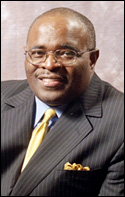MLUI / Articles from 1995 to 2012 / NAACP and MLUI:
NAACP and MLUI:
Two Organizations, One Melody
March 9, 2005 | By Hans Voss
and Heaster Wheeler
Great Lakes Bulletin News Service
HEASTER WHEELER HANS VOSS
Just as pianists must play their instrument’s black and white keys to make great music, so must America draw on her black and white citizens to make a great country. That is why the partnership between the Detroit Branch NAACP and the Michigan Land Use Institute is music to the ears of those who believe in reaching across racial, cultural, and geographic boundaries. And that is why our shared vision must resonate throughout Michigan, from its great southern cities to its splendid northern forests. 
Executive Director
Detroit Branch NAACP 
Executive Director Michigan Land Use Institute
Our hopeful partnership aims to replace the unfortunate dearth of urban voices addressing land use issues with a new song that unifies city and countryside in ways that, even very recently, few would have thought possible. Without it, there will be little progress in urban revitalization or land preservation.
Living for the City is a vital first step. Focusing on Detroit, we are addressing three issues crucial to its long-delayed renaissance: Public transit, affordable housing, and race relations.
Public transit’s goals: Accessible, reliable, convenient, and affordable.
Detroit once operated the nation’s largest municipally owned transit system. Fifty years ago, that system annually carried 492 million riders; the Woodward Avenue trolleys rarely required more than a five-minute wait. Today, Detroit’s transit system is an embarrassment and a trial for those who use it. Yet one-third of Detroit residents have no car; for them, getting to work can be a nightmare. They are constantly at risk of losing their jobs because the buses often make them late for work. Dependable public transportation is a basic necessity that Detroit simply must regain.
Every family deserves a decent home.
A significant measure of any community’s economic competitiveness is its supply of quality affordable housing. Here Detroit faces significant challenges, as families struggling to survive on low or moderate incomes compete with each other to rent one of the only 5,635 homes available to them through a federal assistance program. Nearly 10,000 families are on the waiting list. And both the successful renters and the anxious waiters know that actually owning a home is a distant dream.
Race relations: The quest for fairness and equality goes on.
Despite civil rights legislation and affirmative action programs, race still influences where people can live, work, or relax. Michigan, the most segregated state in the nation, has five of the nation’s most racially segregated metropolitan areas: Detroit, Saginaw, Flint, Benton Harbor, and Muskegon. While one in seven of the state’s residents are African-American, most live in just a few areas. In Detroit, eight out of every 10 residents are African-American, and 82 percent of the black students in Wayne, Oakland, and Macomb Counties are enrolled in just three of the region’s 83 school districts.
Michigan cannot realize its full economic, educational, or social potential without full and equal opportunity for every citizen. We hope that this report helps to make the Motor City a model for sustainable growth, livable communities, and a revitalized economy.
Now, wouldn’t that be music for the people of Detroit — and for the entire state?





